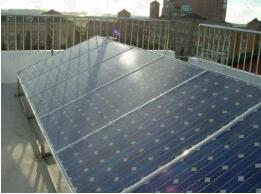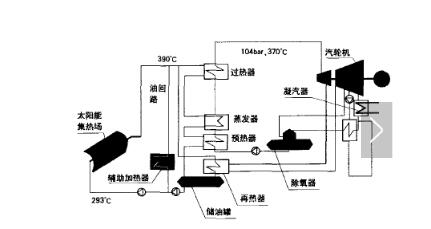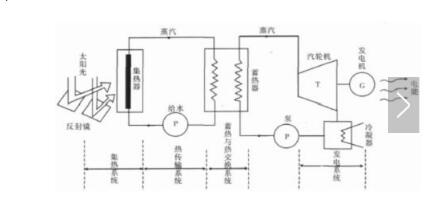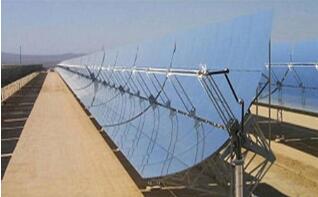Solar thermal power generation is a method that converts sunlight into heat energy using specialized collectors, which then drives a thermal cycle to produce electricity. It plays a significant role in the broader application of solar energy. Since the 1980s, countries such as the United States, Europe, and Australia have developed various demonstration systems, advancing the technology significantly. Globally, there are three main types of solar thermal power generation systems: trough line focusing systems, tower systems, and dish systems.
**Classification of Solar Thermal Power Generation Systems**
1) **Trough Line Focusing System**
This system uses parabolic trough mirrors to concentrate sunlight onto a tubular receiver. The heat transfer fluid inside the tube is heated, producing steam in a heat exchanger, which then drives a conventional steam turbine to generate electricity.
2) **Tower System**
In this system, a field of heliostats (sun-tracking mirrors) focuses sunlight onto a receiver located at the top of a central tower. This setup creates high temperatures that can be used for power generation or thermal storage.
3) **Dish System**
The dish system consists of a large parabolic mirror that focuses sunlight onto a receiver at its focal point. This system often uses a Stirling engine to convert the heat into mechanical energy, which is then transformed into electricity.
4) **Comparison of Three System Performance**
Among the three, only the trough line focusing system has been commercially deployed, while the others are still in the demonstration phase. All systems can operate using only solar energy or in combination with other fuels, offering flexibility and potential for future commercialization.
To gain a deeper understanding, let’s explore the trough line focusing system in more detail.

**Trough Solar Thermal Power Generation System**
The trough type solar thermal power generation system, also known as the parabolic trough system, utilizes long, curved mirrors arranged in series to focus sunlight onto a central tube. This heats a working fluid, typically oil or water, which is then used to generate steam and drive a turbine for electricity production.
**First, the Working Principle of Trough Solar Thermal Power Generation System**

The principle involves a parabolic trough mirror that focuses sunlight onto a pipe located along its focal line. The heat transfer medium inside the pipe is heated to around 350–390°C. This hot fluid then passes through a heat exchanger, where it generates superheated steam. The steam powers a conventional steam turbine, which in turn generates electricity.
**Second, the Technology Adopted by the Trough Solar Thermal Power Generation System**
1. **Medium Temperature Technology**: Uses heat transfer oil or molten salt to collect heat below 400°C and generate steam via heat exchange.
2. **High-Temperature Technology**: Utilizes mixed nitrate as a heat carrier, collecting heat up to 550°C and generating steam through heat exchange.
3. **DSG Direct Steam Generation**: Directly uses water as the working fluid, heating it in the collector tubes to produce steam for power generation.
Depending on the technology, the system can be either a single-loop or dual-loop configuration.
**Third, the Composition of the Trough Solar Thermal Power Generation System**

The system comprises several key components:
1. **Concentrating Collector System**: The core part, consisting of mirrors, receivers, and tracking devices. Receivers can be vacuum tubes or chambers, and tracking methods include north-south, east-west, and polar-axis.
2. **Heat Transfer System**: Includes preheaters, steam generators, superheaters, and reheaters. When oil is used, a double-loop system is common; when water is used directly, the system is simplified.
3. **Power Generation System**: Similar to traditional power plants but includes special switching mechanisms for the working fluid between the receiver and auxiliary systems.
4. **Heat Storage and Heat Exchange System**: Essential for maintaining stable operation during cloudy periods or at night. Common storage methods include sensible, latent, and chemical heat storage.
5. **Auxiliary Energy System**: Used at night or during rainy days to maintain system operation, reducing the need for large heat storage investments.
**Fourth, Heat Transfer and Exchange System**
The heat transfer fluid is heated to about 400°C in the trough collector. Due to the long pipeline, insulation is crucial to reduce heat loss. Shorter pipes are preferred, and longer ones require pumps to circulate the fluid efficiently. Common fluids include phenyl ether mixtures, pressurized water mixtures, and heat transfer oils. Heat transfer can occur through direct contact or phase change methods.
After passing through the heat exchanger, the fluid heats water to around 300°C, producing steam that turns a turbine and generates electricity. To ensure stability, the system often includes heat storage tanks—high-temperature and low-temperature types. For fluids that may freeze, an auxiliary heater is necessary. In cases of insufficient solar energy, natural gas or other fuels can be used to maintain turbine operation.

**Fifth, Heat Storage System**
Due to the intermittent nature of solar energy, heat storage is essential for consistent power generation. Heat storage is categorized into four temperature ranges: low, medium, high, and ultra-high. Common materials include hydrated salts, heat transfer oils, molten salts, and zirconia balls.
Storage methods include:
1. **Sensible Heat Storage**: Uses materials like water, oil, rock, or sand. Low cost, easy to obtain, but has limited heat capacity.
2. **Latent Heat Storage**: Stores energy through phase changes, allowing higher storage density. Requires materials that can undergo thousands of cycles without degradation.
3. **Chemical Heat Storage**: Offers high storage capacity and compact design. Requires reversible reactions with safe, non-toxic reactants.
Each method has its own advantages and challenges, making the choice of storage system dependent on the specific needs of the power plant.
Explore premium Schuko Power Strips designed for seamless use across Germany and continental Europe. Featuring Type F sockets (CEE 7/4), these multi-outlet extension cords deliver safe, grounded power to EU-compatible devices like appliances, computers, and chargers. Ideal for European travel, offices, and homes in regions requiring Schuko compliance (e.g., Austria, Netherlands, Spain). Our strips include surge protection, fire-resistant casings, and child safety shutters meeting TUV CE/RoHS/REACH certifications. Choose from compact 3-socket to heavy-duty 8-port designs with 1.5m–5m cables.
Schuko Power Strip,European Schuko Power Strip,YG Schuko Power Strip
Yang Guang Auli Electronic Appliances Co., Ltd. , https://www.ygpowerstrips.com